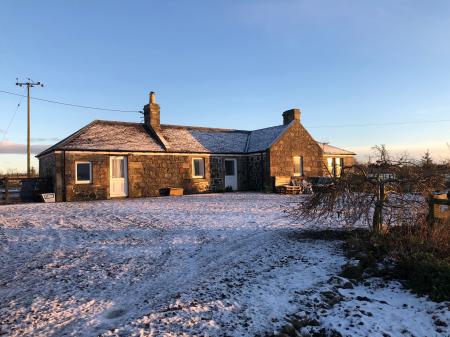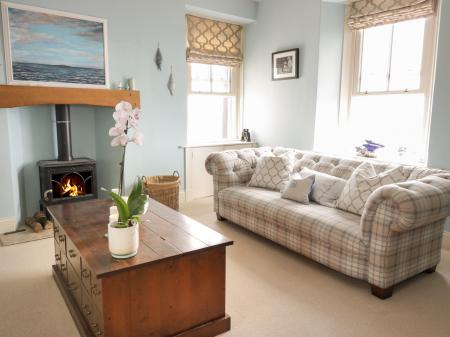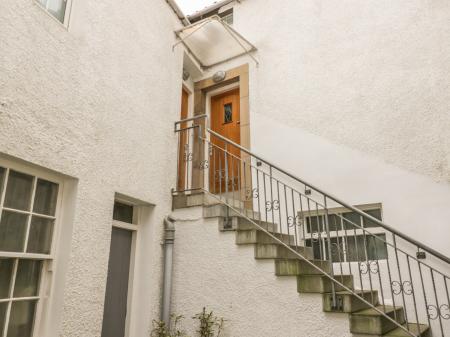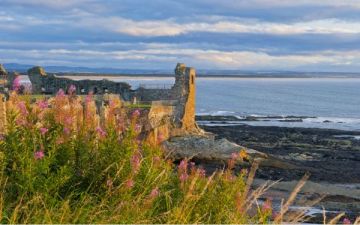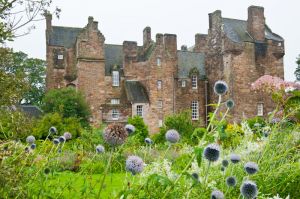
History
The earliest record of Kellie comes from 1150, in a charter of David I. In the early 13th century Kellie was held by Robert of London, a bastard son of William the Lion, but in 1266 the estate was granted to the Siward family of Northumberland.
The Siwards made the mistake of supporting Edward I in the Scottish Wars of Independence. As a result, they lost all their Scottish estates, including Kellie. However, the castle did not completely leave the Siward family; it passed to an Oliphant relative who was married to the youngest daughter of Robert the Bruce. The Oliphants built the oldest part of the existing castle, including the large square tower at the northwest corner.

The 5th Lord Oliphant added a large central block and another tower to the south in the late 16th century. Unlike the earlier medieval tower, these were in in the Renaissance style fashionable at the time. Unfortunately, the expense of expanding Kellie bankrupted the Oliphants, and they were forced to sell the castle in 1613.
The new owner was Sir Thomas Erskine, a childhood friend of James VI. James named his old friend the first Earl of Kellie in 1619, but even before then Erskine was able to play host to the king when he returned to Scotland for the only time in 1617.
The Jacobite Earls
The Erskine Earls of Kellie were Jacobites and suffered for their support of the Stewart cause. The 4th Earl, Alexander, fought with Charles II at Worcester in 1651 and was imprisoned in the Tower of London as a result. The 5th Earl threw his support behind Bonnie Prince Charlie in 'The Forty-Five' Jacobite Rebellion.
After the Jacobite defeat at Culloden in 1746, the Earl spent the summer hiding in a beech tree in the castle garden. His faithful butler brought food to him every day, but in the end, his secret was revealed and he spent three years as a prisoner in Edinburgh Castle.

Victorian gardens
The castle gradually fell into disrepair and ruin, but in the late 19th century it was completely restored thanks to the Lorimer family. The Lorimers originally rented Kellie as a summer retreat, but eventually purchased the house outright and returned it to its former glory.
One of the Lorimers was Hew, who came to be recognised as one of Scotland's best 20th-century sculptors, and who gave Kellie to the National Trust for Scotland in 1970. There is a permanent exhibition on Hew Lorimer's life and works at Kellie.
Another Lorimer to leave his mark on Kellie was Hew's father, Sir Robert Lorimer (1864-1920), who became a prominent architect. At the age of just 16, Robert laid out the wonderful gardens that surround the house. He also helped restore the 17th-century plaster ceilings and the painted panelling and designed new furniture for the house. Sir Robert was responsible for the summerhouse in the garden, where you will find a display in the history of the garden.
I daresay at least as many people come to Kellie today to see the gardens as to enjoy the castle. We came on a desperately rainy day, but the showers eased in time for us to explore the gardens. They truly are a delight. The organic walled gardens were laid out in the 17th century, but altered in the Victorian period, and include collections of old-fashioned roses.
The highlight of the interior is the 17th-century painted ceiling in the library, installed to honour the visit of James VI. The Dining Room is decorated with colourful panelling painted by Dutch artists in 1676.
What to See
- Amazing 17th-century plaster ceilings
- Painted panelling
- Fine furniture
- Late Victorian gardens with old roses
- Woodland walks
- Hew Lorimer sculpture exhibit
- Mural by Phoebe Anna Traquair, Arts and Crafts luminary






 We've 'tagged' this attraction information to help you find related historic attractions and learn more about major time periods mentioned.
We've 'tagged' this attraction information to help you find related historic attractions and learn more about major time periods mentioned.